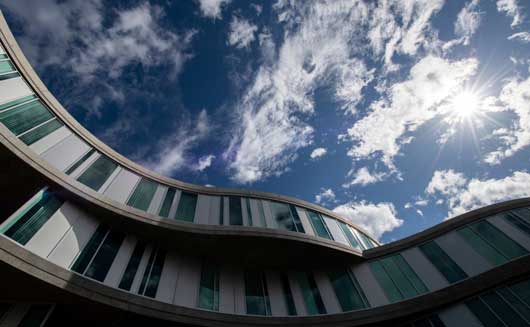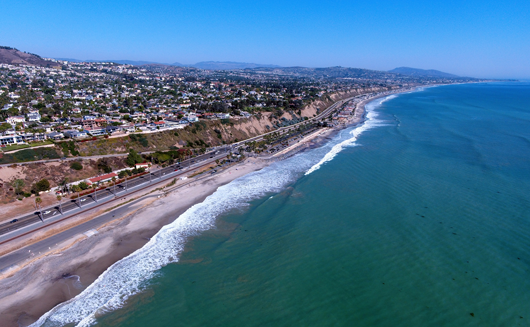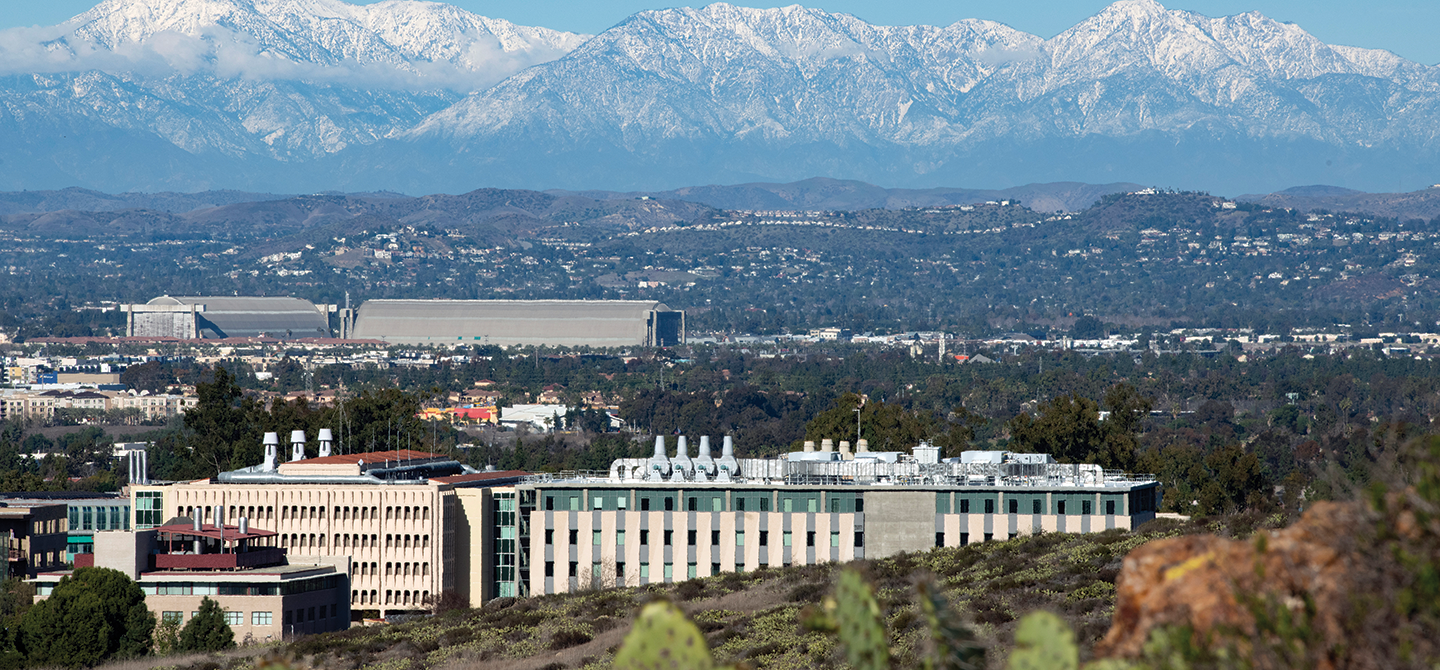
The cool campus
For more than a decade, UCI has been celebrated as one of the nation’s most environmentally conscious campuses, including 12 consecutive years at the top of the Sierra Club’s “Cool Schools” ranking. Recently, UCI beat 900 other colleges and universities across 40 countries to earn the best score from the Association for the Advancement of Sustainability in Higher Education’s sustainability rating system.
But as the saying goes, it’s not easy being green. From designing eco-friendly buildings that power high-tech research to teaching students how to compost in their apartments, sustainability at UCI requires a dedicated effort and all hands on deck.
“I don’t think we always knew how to harness our collective power,” says Anne Krieghoff, a UCI sustainability program manager. “You’ve got to involve everybody in the process – from the chancellor to the boots on the ground. You can be idealistic, but you really need everybody.”
While no one can pinpoint exactly when UCI’s environmental coolness started, most agree it was well underway by the time chemistry professor F. Sherwood Rowland and postdoctoral scholar Mario J. Molina won the 1995 Nobel Prize. Their groundbreaking research linked the growing hole in the Earth’s protective ozone layer to synthetic chemicals then common in aerosol products, leading to global policy changes.
Wendell Brase, associate chancellor for sustainability, has made energy efficiency a priority at UCI since the 1990s – not only to save the planet, but also to reduce the campus’s high energy costs amid state budget cuts. In 2011, when the U.S. Department of Energy challenged institutions to cut energy use 20 percent by 2020, Brase made sure UCI was the first to the goal post, seven years ahead of schedule, drawing accolades from President Barack Obama in his 2014 UCI commencement address.
But modifying energy use at that scale requires more than turning off the lights when leaving a room. Brase focused on what’s known as deep energy efficiency: retrofitting heating, cooling, lighting and control systems in existing facilities to slash their power consumption by at least half. While labs take up only 20 percent of space at UCI, they consume more than 50 percent of the campus’s total energy, with fans, filters and deep freezers whirring 24/7. Brase worked with teams of engineers, environmental safety leaders and designers to develop
Smart Labs, a system of software and sensors to optimize energy efficiency in research facilities. The UCI Smart Labs protocols have been adopted at seven U.S. national labs, including the Centers for Disease Control and Prevention.
“We’re always thinking about solutions that scale up in California and globally – that’s part of the mission of the university,” says Brase, who partners closely with faculty experts to put their ideas into practice. “At UCI, we don’t stop at studying a serious environmental problem. We ‘walk the talk’ and generously share all our sustainability practices and innovations with other institutions around the world.”
While the campus’s ever-expanding footprint makes sustainability more challenging, being “under construction indefinitely” has its benefits. Thirty-two newer UCI buildings have been certified by the U.S. Green Building Council’s Leadership in Energy and Environmental Design program, which evaluates the sustainability and resource efficiency of projects. And 21 of UCI’s new buildings earned the top honor of LEED Platinum – more than anywhere else in the nation.
Better Behaviors
Big-ticket projects aren’t the only focus of campus leadership. Small-scale behavioral changes can add up to major impact as well. Carrie Metzgar, UCI sustainability and planning analyst, runs a popular Green Labs program that educates lab staff and researchers on how to keep their lab humming at optimal efficiency. For example, she gives away dusters to participants to clean the coils and vents on their deep freezers, a simple act that can reduce energy use by 25 percent and make the appliances last longer.
“Training students to become researchers who are mindful of sustainability has a ripple effect as they go on to careers – and can even be that little thing that takes them to the next level in a competitive hiring environment,” Metzgar says. Some grant makers have started considering the climate impact of labs they support, tying funding to sustainability.
Metzgar points out that some researchers may already be using sustainable methods without even realizing it.
“These daily practices are easier than folks tend to think,” she says. “Using natural light instead of overhead lights when possible, shutting the fume hood sash when not in use, reporting water leaks, sharing equipment and supplies with neighboring labs. It’s important for us, as UCI community members, to understand that simple habits to improve sustainability do, once they’re multiplied, have a significant impact.”
Zero Waste
A campus of 56,000 students, faculty and staff inevitably sheds a lot of detritus. UCI produces 10,000 tons of trash a year but manages to keep 80 percent out of landfills – the best diversion rate in the University of California system. The campus continues working toward the UC’s goal of “zero waste,” which, in practice, means a 90 percent diversion rate, since there will always be some waste that can’t be recycled, reused or composted.
Just 15 years ago, UCI’s diversion rate was a mere 10 percent. That’s when social ecology alumna Anne Krieghoff joined Facilities Management and introduced a campuswide paper recycling program.

Just 15 years ago, UCI’s diversion rate was a mere 10 percent. That’s when social ecology alumna Anne Krieghoff joined Facilities Management and introduced a campuswide paper recycling program.
“When you think about curbing climate change, trash is your gateway drug,” she says. “It’s the one thing we all can do something about.”
Over the years, Krieghoff helped add more recycling programs. Today, UCI’s food waste goes to the LA Sanitation District, where anaerobic digesters convert the calories into electricity and recycled water. Campus tree trimmings go to the Orange County Great Park for composting. Even Styrofoam – that environmental anathema – gets reborn as surfboards, thanks to a local company, or compressed into reusable “bricks” that can be made into new Styrofoam.
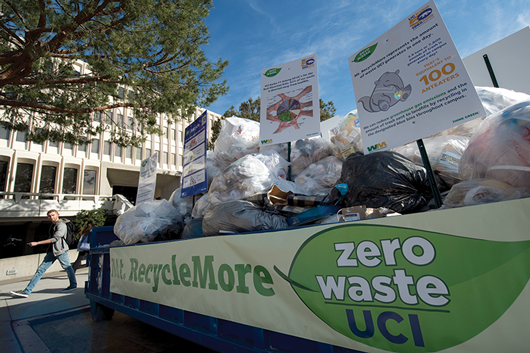
One significant challenge still ahead: phasing out single-use plastics by 2030. On-campus eateries have already shifted to compostable utensils made of corn starch, and this summer, plastic bottles will be discontinued – even those from the ubiquitous Pepsi vending machines, which will revert to aluminum cans and boxed water.
If you’ve ever stood puzzled before a bank of bins labeled “recycle, compost and landfill,” then you needed a UCI “trash talker,” a student trained to help guests at large events sort their paper plates, dirty napkins and bread crusts into the proper receptacles. But diverting waste can only go so far on a planet with a growing number of inhabitants and a finite amount of space.
“In the last five years, we’ve seen a shift toward focusing on reducing what you use, not just thinking about it being recyclable,” Krieghoff says. “For example, think about getting Amazon to put all of your items in one package instead of multiple boxes and shipments. People are starting to get on that bandwagon.”
Goodwill bins in every on-campus housing community enable students to donate 60 tons of clothing and other used items each year – that’s equivalent to the weight of 36 cars.
“We’re teaching first-year students how to live sustainably,” Krieghoff says. “They’ll learn it here, then they’ll take it with them wherever they go.”
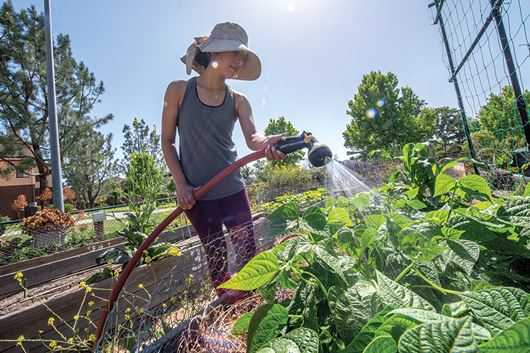
Green Eating
Anteaters like to eat – it’s right there in the name. UCI Dining Services, which partners with Aramark, serves more than 12,500 meals every day and aims to make eating on campus sustainable while cutting down on waste. Long gone are the days of going to a dining hall and piling a tray high with plates of food. Dining is trayless, and students are gently yet frequently reminded not to take more than they can eat.
“When I was a student, I remember taking my tray and going to Pippin Commons in Middle Earth and stacking up all the food I could,” says Metzgar, who graduated from UCI in 2011. “What going trayless has done to help reduce food waste is incredible.”

The Anteatery and Brandywine dining halls are among the first zero-waste dining facilities in the UC system. While efforts are made to match supply with demand, including cooking in small batches to prevent waste, any prepared dishes that haven’t been served get donated to local food pantries.
Residents also receive reusable cups, silverware and clamshell containers for to-go orders, so instead of onetime use disposable items, they can return everything to be washed and reused.
Sustainability is part of the food sourcing process as well. Produce comes from within 250 miles of campus; all eggs served are cage-free; and dining halls have been designated as fair trade since 2018. On the patio outside Mesa Court’s Anteatery, 30 vertical gardens yield 1,800 bundles of leafy greens, squash, tomatoes and herbs every month. The aeroponic towers use 90 percent less water and grow at least twice as fast as conventional gardens.
The dining halls also lean into plant-based food options, where nearly one-third of meals are now vegan or vegetarian.
“We’re introducing the concept that food is not only meat and potatoes or burgers and fries,” says Anteatery executive chef Sharron Barshishat, who is vegan. “This is the perfect environment to introduce a variety of flavors as we feed students who are the future leaders of our society.”
Student Power
Students too are keen to advance environmental initiatives at UCI. Last year, two undergraduates spearheaded a campaign to have UCI formally designated as a Bee Campus USA, establishing a committee to ensure that the campus hosts pollinator-friendly plants.

Even before that, students were maintaining four gardens on campus, planting, tending and harvesting fruits, vegetables and flowers. Seed libraries at several locations encourage students to try out their green thumbs at home or in the community gardens – or donate seeds from their own successful plantings. Campus coffee shops regularly give away coffee grounds for gardening, body scrubs or other do-it-yourself projects.
Additionally, students were the driving force behind UCI becoming the first U.S. university to fully electrify its campus bus fleet, back in 2017-18. Anteaters voted to raise student fees to fund the purchase of 20 electric buses, which provide 2 million rides each year around campus and neighboring communities. Before fall quarter begins, student funds will expand the fleet by 25 percent.
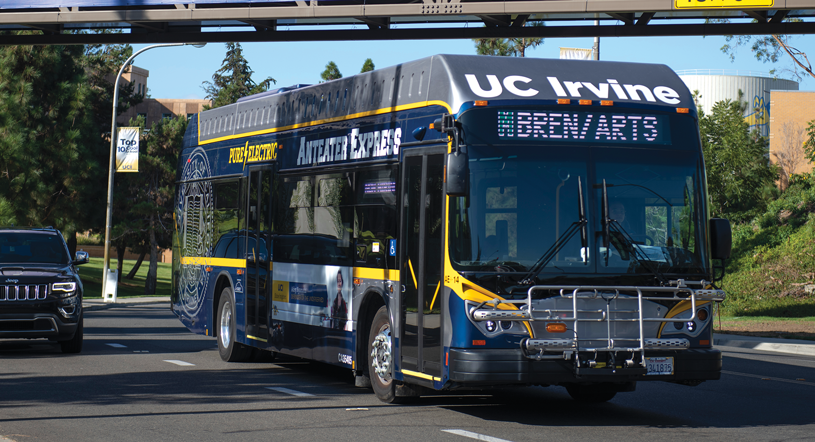
The Green Initiative Fund, managed by students and also financed by a fee initiative, supports projects every year that range from campus water bottle refilling stations to research and signage at the San Joaquin Marsh Reserve, on the northern edge of campus.
UCI Student Housing annually trains 20 “EarthRep” ambassadors who serve as peer-to-peer sustainability educators in their residential communities, and student “green captains” at every dining location coordinate educational activities like trivia games and buffet-style displays of untouched food thrown away by diners.
The Student Leadership Institute for Climate Resilience, an intensive, three-day training program developed at UCI and hosted by the UCI Sustainability Resource Center, is currently being adopted and piloted on other UC campuses.
“Our dedication to sustainability inspires and is inspired by the students,” says Rachel Harvey, sustainability program manager for UCI Student Housing, who runs several training and internship programs. “We endeavor to meet them where they are. If they come in excited about recycling and waste reduction, we provide training and opportunities for peer-to-peer engagement. When students are ready for more, we help them engage with topics from carbon offsets to environmental justice work to the green careers of the near future.”

Alyssa Romea is a third-year undergraduate studying political science and environmental science and policy who helped spearhead the Bee Campus USA initiative and now serves as an academic coordinator for the Sustainability Resource Center, speaking to classes about issues she’s passionate about.
“When I first applied to UCI, I worried about the sense of community at such a large school. But the sustainability community here is strong,” Romea says. As she soon discovered, Anteaters have over 20 student organizations dedicated to sustainability.
“Students here see problems and have ideas and initiative to want to change them,” she says. “It’s about finding resources and professional guidance to see those innovations come to life, and the SRC gives us access to resources, faculty and staff to actually make a difference.”
Ultimately, the impact of UCI’s sustainability programs extends beyond the campus and past the current moment.
“We’re not just creating a sustainable UCI,” Metzgar says. “We’re preparing a new generation of leaders who feel ready and empowered to contribute to creating a more sustainable, resilient, equitable and livable world.”
- Christine Byrd (originally featured in UCI Magazine, Spring 2022)

